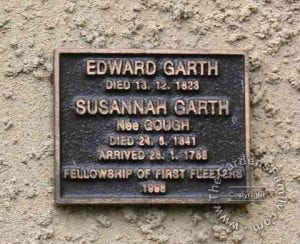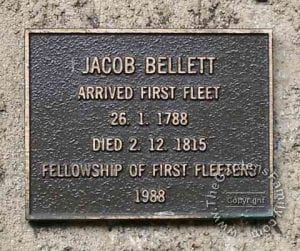Article from http://www.fellowshipfirstfleeters.org.au/edwardgarth.htm

Edward Garth was indicted for feloniously stealing on the 29 October 1784, two live cows, being the property of Thomas Rhodes the younger. He was sentenced to death but reprieved on 3 March 1785 to transportation to Africa for seven years. His reprieve was based on witness accounts who described him as a hard working lad in the 14 years he had known him while another offered to employ him if he was acquitted.
Following time spent in the prison hulk Ceres, he was sent to Portsmouth for embarkation on Scarborough. Immediately on arrival at Port Jackson, Edward was selected to go with the first group to settle Norfolk Island. On 12 February 1788 Phillip Gidley King was appointed Superintendent and Commandant of the settlement at Norfolk Island. King landed at Norfolk Island with soldiers, convicts which included six female and eight male convicts and supplies on 5 March 1788. Here Edward married Susannah Gough a convict. The settlement of Norfolk Island had three distinct periods. The first two were penal settlements, 1788-1814 and 1825-1853. Edward was on the island from March 1788 until 1807 and during different times in the first period more people were sent to the island to relieve the strain on the mainland colony where food was scarce.
During the time on Norfolk Island people were classified into 1st, 2nd and 3rd class inhabitants. Edward was an assigned second class settler and as such was entitled to be victualled and clothed for two years at public expense and was allowed two convicts for one year and two convicts for fifteen months longer. Edward was variously described as conducting himself well and had a large family of a wife and seven children with 30 acres of cleared land. His house on the island was described as shingled, boarded and floored and had three outhouses of logs all valued at 65 pounds. Thus, through his diligence in the colony he came to own substantial holdings. He also became a night watchman and a member of the Norfolk Island Settler Society.
In 1807 Edward and his family were sent on the second embarkation on the 26 December 1807 to Van Diemen’s Land on HMS Porpoise. On this journey he was allowed to take fifteen male sheep and seven grown sheep to restart his new life in VDL. Porpoise arrived in VDL on 17 January 1808, twenty years after the first fleet had arrived in Sydney Cove.
On arrival in Hobart Town Edward was granted 93 acres at Sandy Bay which he farmed with his growing family. Here there was at one time a headland known as Garths Point. The family remained on the land for 115 years from 1808 to 1923 and are remembered by the naming of Garth Ave in the area. In 1813 he received a further grant of 33 acres and during his remaining years had extensive holdings at Clarence Plains & Browns River.
Edward died on 13 December, 1823 at his farm at Sandy Bay/Brown’s River now called Kingston, aged 55 and is buried at St Davids Hobart. Tasmania.
At the time of his death Edward and his four surviving sons had 500 acres of land, 270 head of cattle and 3,650 sheep. The family also had grazing licenses.
Susannah Garth/Grates/Gough was born in 1763 and was one of the female convicts being, indicted, on the 9th August 1783, for feloniously stealing, nine one-guinea coins and one half-guinea coin, the monies of William Waterhouse and charged as having been stolen, privily from his person. Some money was found on Susannah and her accomplice, Elizabeth Dudgeon. Reports in Mollie Gillen’s Founders of Australia state ‘interestingly Susannah swallowed eight guineas which promptly made her sick and she later brought them up’. She was found guilty of stealing and sentenced to seven year’s transportation.
Some reports suggest that while waiting aboard the hulk Mercury she was one of 66 prisoners who scrambled down the side of the hulk as part of the mutinous escape but was recaptured and sent to Exeter Gaol. Later she was sent to the Dunkirk hulk and from there to Friendship on the 11 March 1787. However, family history research conducted suggests, that she has at times been confused with her later accomplice, Elizabeth Dudgeon because as she was tried in 1783, the ‘mutineers’ were from the time of 1782 trials. Thus this is most likely not the Susannah Garth mutineer but her accomplice, Elizabeth Dudgeon using her name as an alias. Susannah Garth (of this story) did embark on Friendship on the 11 March 1787 bound for Botany Bay. At Rio on the 11th August, she was one of six women exchanged and transferred to the Charlotte.
Later reports on arrival in the colony of New South Wales indicate Susannah’s subsequent behaviour as much improved. Immediately following the First Fleet’s arrival in 1788, at Sydney Cove, she was selected/ volunteered as one of the group of women convicts to go to Norfolk Island with Philip Gidley King. Her volunteering is believed to have been in place of Nancy Yeats/Yates, partner of Judge advocate Collins, who wished to remain behind with Collins.
At Norfolk Island in 1795, Susannah married Edward Garth and over the following years seven children were born to them, with one dying at Norfolk Island. The children were five sons (four surviving infancy) and two daughters. With her husband and six children, she left Norfolk Island on 27 December 1807, for Van Diemen’s Land (Tasmania), by Porpoise and lived on lands at Clarence Plains and Queensborough, Tasmania.
At a later time in her life Susannah had the distinction, as recorded in other family history reports in From Chains to Freedom by Thais Mason, of being the first woman to set foot on Norfolk Island (p17). This statement was made under oath when she was a witness at a hearing in Hobart in 1836.
Following Edward’s death in 1723 Susannah was left a widow but his property was bequeathed to her and two sons and a daughter. She remained on the family property for the rest of her life.
Susannah died on 24 June 1841 at Hobart, age given as 78.
Sources: Mollie Gillen : The Founders of Australia;
Thais Mason : From Chains to Freedom : A history of the Garth Bellett Family 1788-1982.
#8430 Logan Cherry
